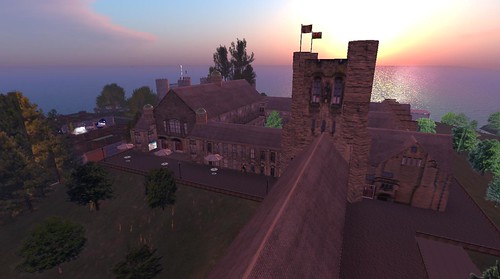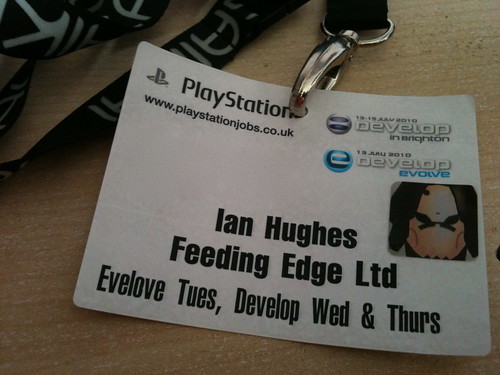I recently joined the panel at the Train for Success event in Second Life where we (Anders the host, Dusan Writer, Maria Korolov and myself) were there to discuss the pulling back from pure enterprise firewalled virtual world solutions by Linden Lab and a focus on the consumer experience. In part of that we talked about the various game related technologies that come into play in delivering a virtual world. Lots of the focus, quite naturally, is on the front end though I did point out the challenge of any MMO is the server based synchronization. In many ways we can get a browser or client to do all sorts of wonderful immersive stuff but its much harder to share a lag free experience and distribute to those clients.
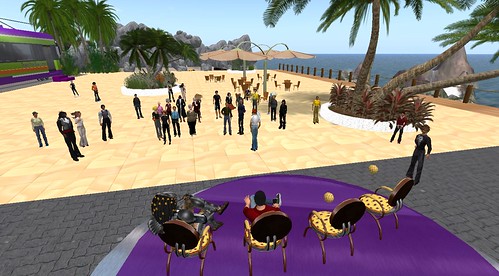
It was interested to take the role of the “techy who knows a bit about game platforms”.
All of us responded in pretty much the same way that yes enterprise SL was not packaged and sold right, nor given the time to evolve but that we all use Second Life still as we blend business and social in so many ways. It was where I started to get traction with my colleagues and customers in 2006.
At the end we got onto what needs to extend to an even more interesting conversation as whilst the technology can continue to evolve and get better, faster etc it is the things we do with it and the creative endeavours that create interest and engage people.
Whilst there was an uphill battle to get the more mainstream business people to get over the apparent frivolous nature of avatar mediated communication this next wave is really go to scare them and challenge them.
Many of the IT departments and policy makers have decided “We don’t play games at work on our PC’s” that is the mantra used to block the use of anything remotely interesting. It is not without some reason, but the seed of reason grows into a giant forest of objection and darkness. Explaining, or showing that places like Second Life and Opensim etc are not games, just game technology used for another reason doesn’t always chop down the forest.
Now of course there is the gamification wave. The implementation of game mechanics and ideas into every application and walk of life. Business is a game, saying the right things to get that promotion is a game, getting the promotion is a badge earned and worn, winning the sales competition and going on a jolly is like a rewarding cut scene after a tough mission.
Many of these game mechanics, remembering the IT department “we don’t play games at work” mantra will not even touch any of the IT systems in a way they will notice. An Alternate reality campaign inside a corporation may use the phone system, emails, noticeboards etc. All hiding the game elements as a payload inside everyday tools.
At some point though, someone, somewhere, is going to say why cant we do this in a wonderful hi rez generated environment? Why cant we use gesture control like Kinect to navigate the sales figures.
It is a conceptual revolution with a massive social impact, as much as social media and the web. Screwing together plates on a production line is very hard to alter as a physical process to make it less soul destroying. Motivations of speed and efficiency and money for the worker help but ultimately it gets automated. The digital chores we make for ourselves clearly can be altered, you have a family photo as a backdrop on your desktop as a start.
There is a great article from the Harvard Business Review here I know statistics don’t work for the closed of mind as they will discount things that do not meet their believes but this is an interesting quote.
“At SCVNGR, we’ve been able to examine the statistical effects of introducing game dynamics into situations that are decidedly not games. We’ve seen simple game dynamics increase traffic to locations 4X over a matter of days. We’ve seen others extend the average amount of engaged time consumers spend at a business by upwards of 40%.”
Game mechanics motivate and entertain people. People pay to play games that are chores. Surely its in all the more straight laced and ROI induced business people to look at what they and their people do and see if they can spruce it up a bit. Bored or scared people are going to just do the least they need. Motivated and excited people are going to do great things.
So straight laced serious business people who use ‘this is the way we have always done it” whats the point of that…. people the ball is in your court (oh look another gaming/sporting reference).
business
The Spirit of Top Gear – Geek Jazz
On my birthday trip out we all popped along to the National Motor Museum at Beaulieu. It now has a special exhibit which is the contains many of the results of the Top Gear challenges.
I find Top Gear both hilarious and inspirational, and being a moderate petrol head its also a good subject matter.
Seeing the fruits of the production teams labour shows some brilliant, but deliberately flawed ideas.

Everything tends to “not go quite as we expected”. Which is of course the sort of thing you would expect like bolting the two fronts of cars together to make it easier to get away in reverse as above.
Its all brilliantly visual, but any techs out there know that this sort of mad idea and bolting together of things that shouldn’t be bolted together goes on all the time in software, you just can’t see it.
Many a time I have seen a project strap the software equivalent of a Reliant Robin to a large rocket on a tight budget in order to emulate the space shuttle.

Of course the spirit of engineering is to know when to smash things with a hammer and when added strength and design. Top Gear deliberately makes sure they tip the wrong side or working for comedy effect.
The cascade of constant changes and challenges their set piece projects face also mirror what we see all the time. Make something for one purpose and then a hand delivers a new envelope which is sort of what it was meant to do but requires a bit more hacking and bodging on top.
I shouldn’t delve too deeply in the clever approach they have developed, it ruins the magic and the humour.
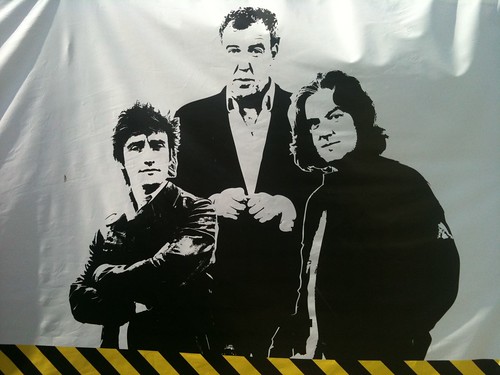
More snaps of some of the pieces here
There is of course a production team hard at work for these guys, whilst they generally shun the sort of tech I deal with on a daily basis they are in fact geeks cut from the same cloth as the rest of us.
In order to hack and bodge things you do actually have to know how to to things properly in the first place, its kind of like Jazz, you need to be a skilled musician to improvise.
Flyer for BCS Animation and Games Development SG – Bangor
The British Computer Society Specialist Group for Animation and Games Development has its first meeting on Wednesday, that all are welcome to in Bangor. As an update to that here is the flyer that has been produced.
Whilst this meeting is not being held in Second Life (yet) Bangor University has an island that you may like to visit here
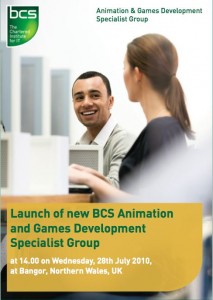
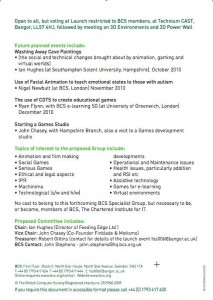
If a BCS member, joining the proposed BCS Annimation and Games SG is possible now via the members area
Anyone, whether BCS member or not, may now register to attend (free of charge) the inaugural meeting of the SG at 14.00 on Wednesday 28 July 2010 at Technium CAST, Parc Menai, Bangor LL57 4HJ. Booking possible via: www.bcs.org/events/registration
At the business session, at 2pm, the constitution for the SG will be formally adopted and the nominees for the committee voted in. This will be followed by the state of the art, ‘3D Environments and 3D Power Wall’starting about 2.30. The event is expected to finish at 16.00.
Hopefully see some of you there, or failing that at some of the events around the country.
Connecting with the human, organisational design
Tom Chatfield recently posted this brilliant explanation in Prospect magazine of transforming engagement by learning through video games . It pulls together many of the current ideas that are circulating around why video games are so successful, such a big business and really something to be taken seriously.
This really is quite simple yet obvious, as all good things are. As Tom explains in the article human beings have evolved of millions of years to have certain triggers and motivations. Video games and virtual worlds have taped into many of those triggers, almost by accident.
The irony is that many of the things that make humans tick are often ignored in organisational evolution. They are also the things that mission statements of companies try to address yet in practice many enterprises and companies do not practice most of these. So, if video games have exposed and proved what makes humans operate and how they are motivated it would make sense to apply these straight away to any organisation that wants the best out of people. I have replicated Tom’s list and put those in context of what most organisations do to not quite address these in a timely fashion.
1. Using an experience system.
This refers to constant achievements, publicly shown and earned. For many organisations this may be an occasional award, a promotion review process. Seldom is it the actual Kudos that individuals and teams earn that is used officially.
2. Multiple long and short-term aims.
Organisations will have strategic and tactical objectives but most people in a job will be set a task. This stems from the industrial mechanisation where we became a simple cog in a machine.
3. You reward for effort.
Most organisations simply reward success. It is a subtle difference, but an important one to reward the dedication and effort put towards a cause.
4. Rapid, clear, frequent feedback.
Not knowing what people are achieving on a day to day basis (as in point 1), with the effort put in (as in point 3) leaves most organisations to work in a batch feedback way. When a team of people bond they support and nurture individual efforts, but that gets diluted in 6 or 12 month review cycles.
5. Uncertainty.
This is pleasant surprise. If you discuss uncertainty, or even the path to discovery and invention, in most organisations you will be met with fear. The biological payback for the buzz of finding something unexpected is lost.
6. Windows of enhanced attention.
The industrial approach of the 9-5 job will not take into account the rhythm of the brain and the body. The times when you mind is open to new ideas and times when it is just time to grind. In helping people understand their creative inventive side we often have to get their brain into the correct gear. Considering combinations of things in unusual combinations, picking random words from a bag and connecting them, discussing seemingly ludicrous extremes, all help the brain get ready to spark. You can’t stay in that state all the time, but creating rather than suppressing that state leads to an easier path to creativity.
7. Other people.
We thrive in groups, the affirmation of others. The rise of social media online has proved that even more. Not to replace the physical but to enhance it. When organisations seek to force this down or engineer it out they are really fighting the human spirit. When you consider the length of time the human spirit has had to evolve and compare it to the time we have had our current business structures you would not bet on the latter would you?
So when considering how to engage with customers, create products, apply government and so on these attributes need to be looked at, but they also need to be applied internally to the organisation creating these engagements. I wonder how many of the really good games design studios have fallen into the corporate trap and how many really live this.
Things I have tried since Develop – Danger, Toys and Zombies
As everyone always says “I don’t have time for x,y,z”. However when it comes to games, virtual worlds, emerging trends and technology I find I have to interact with things and try them out in order to put them in context. Some of the things were just sitting there in some queue, hijacked by other pieces of work. The Develop conference inspired me to go and look at a few things.
1. Bejeweled Blitz on iphone (and other platforms). I find PopCap games brilliantly done, very addictive, but I don’t really want to play them that much. They tend to have the overwhelming feeling they will never end, like a Terminator they will just keep coming. My wife loves them though, and she is rather good at them. Going to the PopCap presentation about Blitz I thought I best have a go on my iphone before the competition to win an iPad. How cool is that, play Bejeweled Blitz for 1 minute (as thats the time limit on the game) highest score wins an iPad. I didn’t win as I am not up to speed on the thing. What blitz does though it make me want to play a bit more. First its only 1 minute at a time, second it publishes the top scores each week amongst your friend on Facebook. So it has some of that asynchronous social gaming in a casual form. So I find myself drawn to it and feel that competition, even though I know I am not up to speed yet i have a target.

1b. Plants Vs Zombies. I put this as related to Blitz as it is a PopCap game. It is another that I had avoided but thought I should give a try after hearing PopCap’s back story. It is a resource management meets space invaders game somewhat like the castle defence genre. It manages to be very addictive and engaging (though has no social component yet). I liked it though, placing plant weapons on a lawn to stop an advancing army of cartoon zombies is suitably mad that it was worth a bit of time playing 🙂
2. Kahoots on PS3 Minis. This is a puzzle platformer out of the Lemmings mould. Also though it is on the PS3 but one of the games that you can drop onto your PSP. So I did. I found myself again compelled to figure out the levels. You know the solution is in there somewhere but with its almost Portal style screen wrap around sometimes the solution is to fall off, which is great.

3. Joe Danger on PS3. Hello Games first foray, a brilliant look to a cartoon style side on bike game. Fluid controls, lots of stunts and combos. It turns out the predlets love it too. It gets a bit tricky but the head to head racing really got them going. Again solving the puzzles, a lot of repeat play make this one cracker of a game. I had seen about it but avoided the PS3 as I was busy on the Xbox. However both Kahoots and Joe Danger sparked my interest in PS3 again.

4. PS3 Home. I had not been in Home for a while again, as I thought there was nothing new to check out. Having talked with a Home developer at one lunchtime session I thought I should go back and check it out. Most of my gamer contacts being on XBL some of the shared spaces I have are not that interesting solo. However I sparked it up, patched it etc and found myself getting the Toy Story 3 “Andy’s Room”. Again this was to see what the predlets thought as much as my interest in how this form of interactive advertising was going to work.
It was somewhat magical to be wandering around, with the added out of context avatar of the predator.
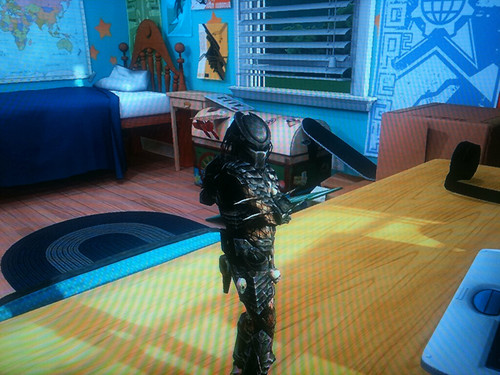
Yes these activities ate into some time, but only a few hours spread over a few days and shared with the family. Seeing how these things engage us socially, become part of our lives is as intriguing as the joy of the various games.
What is not in doubt is the connected nature of these experiences. They are not dumbed down nor less entertaining than a full on AAA hardcore gaming experience. They fit into small slices of time in lifestyles but enhance human bonds.
Day 2 & 3 Develop 2010 – Small is the new big
Day 2 was supposed to start with the guys from Bioware (part EA) with
Creative Game Development: How we do it at Bioware with Dr. Ray Muzyka and Dr Greg Zeschuk.
However there was just one of them. It was quite a rock and roll start for Greg to have to apologise for Ray not being there but he had managed to get himself into the last 500 of the World Series of Poker.
Greg went on to give what was probably an unusual kind of corporate business talk but with a successful and creative game spin to it. As you can see from the pictures if you have ever sat through a corporate powerpoint presentation its pretty much like this. Note the “Interesting Learnings” title.

Having said that it was interesting to see how a small company grew to become a larger one, then get bought by EA (a huge one), then have to merge in other smaller studios under the Bioware brand across multiple locations.
Greg was very articulate and passionate about establishing the culture and the values of a company. (He admitted they had gone off to do MBA’s which explains the ppt). However I think this was not just lip service. I have heard many a corporate spiel on values and been left feeling it was convenient to say those things without backing it up. Equally I have heard, and given, talks with the same true belief in the power of teams and of people.
He indicated that as evolution occurred the culture and people and processes had to adapt but try and stay around the core values. As he also said, this is all obvious but many people do not spend time to consider the structure, who they are and what their way forward is. It sounded as if they had taken a decision early to make sure they both hired for the culture and also indoctrinated the values into those people (in a good way). That formed stronger bonds.
I am not sure who in the audience was into what he was saying though. I was expecting some flashy bang whizz creative explosion on stage, but instead got a very good, very sensible and very articulate presentation on organisational structures.
Next up:
Ed Vaizey : Minister for Culture
It was apparently a new thing for a minister to come and talk, and with all the budget changes little things like tax breaks for the video game industry (another discussion that one) getting dropped there seemed to be some nervousness amongst the organisers that this would all kick off some how. Several intro’s suggested how brave and noble it was for Vaizey to risk turning up. I found that a little patronising to say the least. Vaizey tends to have been a supporter of games and his opening remarks were how the industry attracted people from the “difficult subjects” of computer science, engineering and maths. On a personal note it was hard to listen to him and not think he is like Boris’s coherent brother.
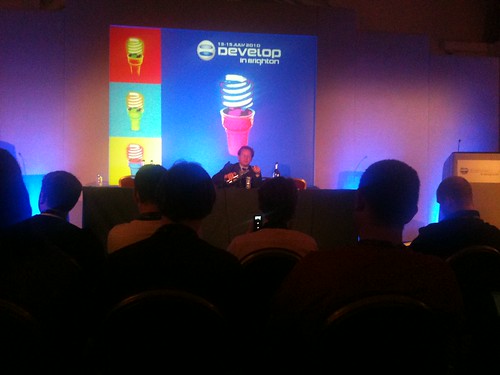
Anyway he read a load of facts and figures, announced some £2million fund out of Abertay for gaming startups, and Ian Livingstone heading up a study or panel on games development education and if it was working. The rest was really just spin, NI contributions, Conservatives good for business etc.
He then sat down and took some questions. Though I do not think there were any specific important answers though somehow it got onto immigration.
He was asked what game he is playing at the moment. There was a ripple of laughter from the audience which may have been the outlet for the sit still children we got at the start. Apparently he is playing “Super Mario on the Wii as that is the limit of what he can do”.
He said he was passionate about the industry, but then he has said that about other things as its a great non action word. He also sang the praises of George Osborne which I suspect was because the whole thing was on TV for the politics show.
The Future IS (changed to Of) Controller Free Games and Entertainment
George Andreas – Changed to Nick Burton of Rare
This was a pitch about Kinect. Rare are close to Microsoft and really the pitch started as a history of what Rare had done and tried out over the years to show they were not simply jumping on the Kinect bandwagon. That may be a little unfair, and certainly Rare have shown a great deal of innovation and cool things over the year, so it may have been part of the corporate theming of the pitch.
Nick recounted some interesting gaming moment from Rare. Including some home brew attempts at the wand approach (way before Sony’s Move)
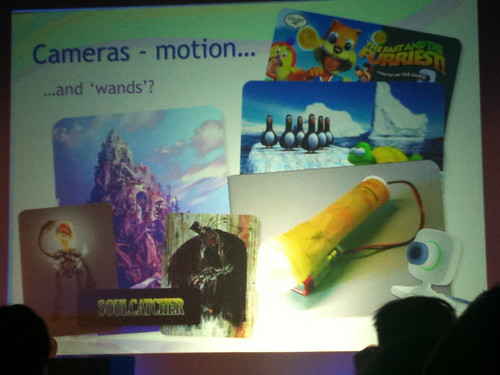
Nick then wen on to talk about Powergloves and a few choice gaming moments, Kameo as a launch title on the 360 etc. The challenged of developing on hardware that is a moving target.
This led onto the core of the pitch. Using Kinect to make a sports game. By getting 3 willing volunteers up on stage and asking them to run on the spot he showed how it is hard to determine what a running movement actually is. Tight arms in knees up running and a sort of Manchester waddle of running being two extremes.
He then went into some depth about altering gameplay and the essence of a game to fit with a comfortable way to play. This centered around football (as in soccer). Running and navigating a 3d pitch whilst possible turned out not to work well from an experience point of view. The essence of football seemed to them to be the set pieces and the kicking of the ball. The long and short of it is really to make football a bit like netball on Kinect. You kick the ball with your body, but don’t run around simply turn your shoulders to face the player you pass to. This is a very practical approach, and clearly one they had to think through. It does make an interesting trade off bit will make the game much simpler to play. Though we will have to wait and see as this was only a video not a live demo.
Homespun Fun – The Art of Kahoots – Ricky and Nat of Honeyslug
This pitch I have already sung the praises of in its own post here. Very much my favourite session of the whole event still.
The Edge Panel – Character Building : Avatars for a User-Generated World
Alex Wiltshire – Edge, Jack Oakman – Realitime Worlds(APB), Jorge Sanchez – Lionhead Studios (Fable2 &3)
Alex opened up the panel bu saying there was a huge rise in user generated content in gaming. Modding etc having driven it forward. He cited Second Life (though he accidentally called it a game, and used Anshe Chung as the reference for making money), World of Warcraft 3d prints (the only mention all conference of that tech).
The panel then discussed the challenges in what are AAA games from a visual design perspective of providing either the tools to create content or huge combinations of rich content that all fit together. Problems of the exponential testing process to make sure one piece of content worked with another.
Fable has a very different approach to APB as they are different styles of game. Fable puts the customization in context of the story, APB uses a more “prim” or sticker based approach to customizing characters and cars to create gangs, stars and quality creations.
One point that interested me was that when asked about making entire worlds not just characters customizable the panel were obviously answering from a cohesive design perspective to say its was impossible to do. Obviously the SL and opensim’s of this world and a good few other platforms are about the entire thing being user generated. If you are a games visual designer and providing a quality game experience the laggy complexities and hacks of a virtual world will not appear on your radar. However… they should as they are starting to solve some of the huge problems that occur in distributing and allowing such creations.
I asked if they expected to have to provide moderation tools for users, i.e. if users wanted to have an authentic experience with great visuals could then suggest that clowns and bad art not be allowed. Its a complicated issue and one that I was not suggesting was automated. The general answer seemed to be clans, but of course that does not help the above clan issue, the land management we see in SL and parcel entry and “rules” people apply or try to in order to keep an experience how they would like it. I cited the role playing of deadwood that requires you change avatar to enter and stay in character. Odd that many people in the games industry are unaware of this side to “gaming”. Still I like APB and Fable so was not going to harp on too long about it. @wonderlandblog and @doctoe were also there so it was good to see some friendly faces despite the odd spotlights in the room.
Panel: The Rise of the Microstudio
Will Freeman : Develop
Sean Murray Hello games (Joe Danger PS3)
Mark Morris Introversion
Robin Lacey BeatNik
Cliff Harris Positech
I really wanted to hear how these guys saw the industry. Such a wide set of experiences. Cliff is a one man army, publishing and promoting as well as building his own games, Robin went from no experience to VC funding and does work for Channel 4, Mark was self funded and with a bunch of friends got going and Sean has recently had massive success but nearly folded and sold his house to keep Joe Danger from going under.
Having come from enterprise myself, now starting out on my own it was great to see we all go through the same stuff. Cliff had used mainstream jobs to keep him going, and was the most passionate about his market.
They guys all got on as they all understood one another’s war stories. Though as the thing went on a late arrival stirred things up a bit, and in a bizzare way. Mark Rein of Epic popped in sat at the front and interjected at how wrong indies were to talk to individual users. Advertising the heck of of everything is the only way. What I found amusing though was that this was kind of a “don’t you know who I am moment” from him, and clearly some of the panel didn’t, which is brilliant. The best post on this was from Cliffski himself *
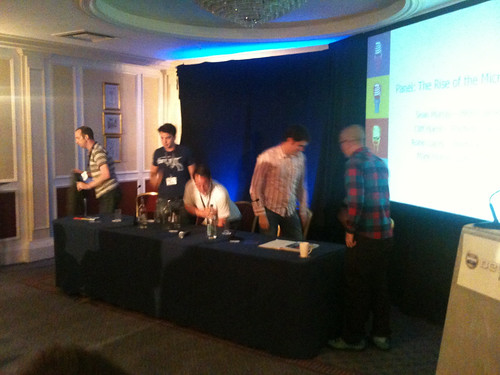
For me it was a ridiculous corporate haranguing in a forum that was about individual personal experiences that really could not be argued with. I know from experience that with a direct approach and engaging with people and meaning it you can get a heck of a lot done. Thats not to see the big guys can easily do that, in fact they are not geared up to do that, but it can make a huge difference. That is the point that was missing for much of the industry still. People are connected, they are bypassing large structures and organising in a different way. The four guys on the panel proved that works as much in the games industry as any other.
****UPDATE To his credit Mark Rein issued an apology and explanation via Develop and to @cliffski. That takes some doing and maybe show there is some interesting middle ground, though small indie and large corporate live by different rules very often.
Anyway after all that many of the key players in the industry went off to an awards dinner where Unity3d got 2 awards including the Grand Prix 🙂 David Helagason was saying as he went off to it he was very nervous, but I am really pleased they did win as they are the shake up the industry needs. Well done to Channel4 for their use of education gaming and getting the hero award too. Brilliant stuff.
Day 3
Successful, Creative, GSOH
Tim Shafer Double Fine
A brilliant opening keynote. Tim is a veteran of the industry and created recent games such as Brutal Legend and before that Psychonauts. However for me he is the creator of Full Throttle and hence can stand up and say whatever he wants. I was not let down as he shared stories in a completely relaxed and suitably irreverent way. In fact the story started with he recounting seeing someone happily vomit in the hotel corridoor on the way back from the bar, without breaking stride. As he said, all these years he has been going wrong being sick in how own room.
He talked about how hard it is do deliver successful multi million dollar games to publishers who quite often will cancel a game in a company reorg. He also talked about how, for some people, to be so into a game development for 4 years may not be a suitable creative outlet.
One of the things he did with his people at his company was take an “amnesia fortnight”. They all went off and did a game jam, 4 teams just came up with 4 ideas and got on with it. Those 4 ideas got parked as they went back to the big development. The team were enthused and sparked and bonded. As it turned out down the line those became the start of a new era of development for the company, working on smaller titles but more of them. So once again small was the new big.
His tales of working with Tim Curry, Jack Black and Ozzy Osbourne were interesting too. He had been warned they were hard to work with, as most stars are. However he found when they were all creating things they all got into it and were great, people just got stand offish when a suit or marketing/PR person arrived in the room 🙂 That rings a few bells.
Time clearly loves his craft and I can see that would permeate any project he was working on. He dealt with some odd questions too, and also got hassled about the fact he had given an interview the day before where he had made a derogatory comment about a leading executive on the production side of the industry. It seemed the crowd were with him on those comments though 🙂 It was a great talk and another inspiration.
3D: The Next Dimension in Gaming
Mick Hocking, SCEE
This presentation was what it said. An exploration of 3D television and displays in gaming, heavily focussed on Sony of course. It was held in a room with a very unusual ceiling. I used this photo as obviously pictures of 3d tv just doesn’t work 🙂

The presenter did a history of 3d, i.e. its been around as long as photography. This quickly zoomed towards the types of polarized and shutter based technology used on screen. The Sony TV’s seem to be active shutter glasses so hence it was indicated this is better as unlike polarized lenses it does not use have the scanline for one image and half for the other.
He explained some of the design and comfort decisions that Sony help people deal with in games. In particular knowing the size of the screen is important. Large to small works, but the other way around the vergence of your eyes when still focussed on the plane of the screen can get painful. i.e. it makes you go too crosseyed. Also with a HUD on the surface of the screen the things in the game can come out and over lap the HUD.
Sony had brought 2 3D screens, stacks of glasses and had the PS3 running some demos. I watched a few seconds of a racing game. As I suspected games are much better than films in this respect. Your brain is ready for the thrills and spills and it was instantly interesting and engaging.
Finally:
Fable III :Story, Cast and Simulation
Peter Molyneux : Lionhead Studios.
Peter turned up a little late but got a live Fable III demo set up. He explained quite often the things that were appalling (his words) in Fable II and how much better Fable III is. To be expected I guess. Still it was good to hear the removing of 2d interfaces, replacing with in context game metaphors such as levelling up being a journey on a road. Also the fact that multiplayer will be a bit more social. As he explained you can meet and marry in world, buy a house together etc. This got a sort of nervous but derisory laugh from the audience, but that sort of engagement is what works in virtual worlds? Not just the very enjoyable fighting and fragging.
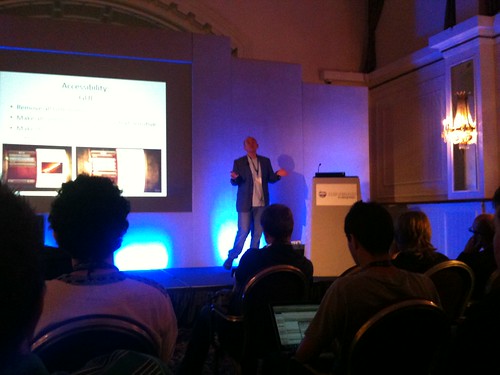
Peter has a lot of critics for being full of spin, but I do like his style and his games are very inventive and enjoyable. Having met and talked with him about virtual worlds and UGC I have a feeling he is on the verge of getting what is going on in the web today, the meet and marry comment alluded to that. However this is still AAA gaming as an industry and it has its patterns and intertia. Seeing the dev version of fable and the hints of LUA scripting etc were quite interesting too. Having cinematics play but Peter saying he was not happy with that move and its being changed etc all good insights.
A very full transcript was taken by Dan Hon, who it was great to see again and who I sat next too through this.
With that I called it a day and came home from Brighton. More enthused than annoyed. Still frustrated the industry is missing out on something rather amazing in virtual worlds, virtual goods, UGC, but also very happy they are not as that give me room to do what I do in this industry too and maybe change it around a little with some of my projects.
Finally I can reveal that the typo on the badges for Evolve was not in fact product placement by CCP as I first thought.
Develop Highlight : HoneySlug, Kahoots and the Peg Monster
There have been some great things at Develop 2010 this past day, but I felt so enthused and invigorated by the presentation by Ricky Haggett and Nat Marco from HoneySlug I had to do a separate post on it. The pitch was called Homespun Fun – The Art of Kahoots. It was (as from the title) aimed at the game artist audience, but quite frankly it was such an amazing tale that it should have been a keynote!
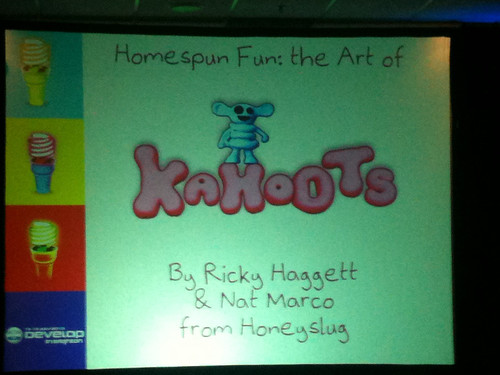
Firstly we have seen a lot of powerpoint at this conference. An awful lot of standard bullet points, though the stories have been interesting. Straight away Ricky and Nat were going to deliver this in a more friendly and accommodating manner, in fact it was like we had just popped into their offices and we were all having a friendly chat (Ricky and I were presenting sessions the awakening creative entrepreneurship last year in Derry so I know this style is very natural for him). Honeyslug is a small 3 person games development company based out of London. The game they were talking about is one that is currently on PSN and is called Kahoots.
The story really is one of just getting on and doing something, creating and discovering ideas on the way. No great plan, no huge budget, in fact no real budget at all. Even more important there was clearly a great deal of enjoyment and fulfilment in the entire project for the close knit team.
Nat did some “preliminary” character sketches in biro on lined paper, as Ricky then said “there were actually no more sketches, that was it design done”
It started as a quick flash demo using some pixel art that Ricky “threw together” in a weekend. The game is a 2d puzzle based trigger the right things at the right time game. The idea for the game was not the core of the pitch it was what happened next.
Having shown the game mechanic worked they had to decide whether to pay a pixel artist to do the characters in the game or try something themselves. Nat had studied stop frame animation at college so one way and another they thought it would be good to make the characters for real. So rather than go an get the proper modelling clay and rigs and armatures they got a stack of the cheapest plasticine they could, some old packing foam and some garden wire and then made the characters. Nat doing a quick tutorial for them then they all had a go. Apparently Ricky’s was a bit fatter then the others so he just was able to peel bits off it until it worked. As Nat said “You can’t do that if you use the really pro modelling gear as you have to shave that down with tools”.
There was a short movie of the fast show stop frame animation modelling scene thrown in. Which added to the happy and playful attitude pervading the room.
Then Ricky pointed out that they did not spend months on the animation, more like a couple of days. It was web cam and cardboard backdrops.
Nat told the story about the other non plasticine character, the Cardborg. This is a cardboard box head and a tin foil body (Jack Black’s robocop in Be Kind Rewind came to mind). The tine foil was a nightmare to animate, it kept tearing and reflected the background that was supposed to be used to key the foreground out in post production
The stop frame animation was then handed over to Ricky, who admitted he learned everything he needed about doing this and photoshop from cut and pasting his friends headshots onto comedy pictures.
Whilst there was a a lot of self deprecation there is such a creative talent with these guys, yes it was just a few clicks and strokes to make the real characters look like computer sprites yet retain the homemade feel, but they were the right clicks.
The rest of the game art was accidentally decided upon. Having made real characters they headed to the charity shops and spent £35 on buttons, sweets, fabric etc. They then tool all that and threw it in a standard scanner. Many of the assets scanned were sweets, which they then went on to eat over the course of the next few weeks. Again the artwork was keyed out and then some colour treatments made to keep it in the style they had stumbled upon.
That then led to the concept that the entire game, with all its bits and bobs was taking place down the back of the sofa. (I love the way this works and flows, to some it may seem backwards but this is innovative spark at its best. Observer the situation, go with the flow and trust you will find the right things on the way and make the most of them.
Then we got to the Peg Beast. The game has a very quirky and amusing guide, the peg beast who sings quirky songs. He cam about because of a random collection of items in the scanner which Ricky spotted and said looked like a dragon. So Peg beast was born visually. Then they decided Peg Beast would be the instructor at the start of a level by singing the tale of what would happen. Ricky sang into a mic some made up words with a comedy voice and Peg Beast came alive. His brother, a musician scored the track. Then the animation of Peg Beast was simple frames in flash, keyed on the audio. As Ricky said he did not bother to isolate the voice, its just the audio track as is so Peg Beast sort of talks and bobs around in a quirky fashion.
The rest of the map and instructions for the game were done with felt tip pin in a sketch scanned in.
Then the side effects of this flow continued. For some press shots they took the Kahoot plasticine models around London and photographed them in key places (these then became achievements rewards in the game). They also went and had a picnic with them. As Ricky said that was the most money they spent on the entire game buying a small picnic set for the Kahoots and a stack of food to eat.
It does not stop there, the plans roll on, Peg Beast is doing a music video ….. etc. etc.
It was so inspiring to see such a homebrew, enthusiastic non corporate, non sanitised approach delivered with enthusiasm and an almost embarrassed at how well it went attitude.
If you have not bought Kahoots I suggest you do it, they deserve the recognition. An Iphone version is on its way too.
They have proved, as they said. Games are a wish fulfilment for both players and the creators.
Being open to ideas, crazy ones, odd ones and in particular ones outside of your field of expertise unlocks a teams creative spirit. Well done Honeyslug!
Peg Beast FTW.
Develop 2010 – Evolve Day 1 – 10% is the answer
Develop – Evolve Day 1
The first day of the 3 day Develop conference proved, as usual, to be very interesting and well worth the trip to Brighton. It’s not a million miles away form home but enough of a trip to make it worth while staying over at the hotel for the after conference conversations.

Matthew Wiggins – Wonderland creators of Godfinger
Making Free apps for fun and for profit.
Matthew @wiggo on twitter is a games design veteran having worked at places like lionhead. His company Wonderland created the hit iphone game Godginger which is published through DoCoMo and uses the plusplus social networking system.
The talk was primarily a case study in moving from an initial design with a price point of $9.99 on the app store to a completely free game. This was, and he referenced it, an example of the variety of opportunities and business model decisions written about by Chris Andersen in his book Free.
Free does not have to mean for nothing, users get the game, enjoy playing it and if the game has merit they play it in large numbers. 10% of the users will want to start paying in some form or other, for kudos, for content. Or when you have a huge number of users advertisers clearly want to direct adverts towards them.
As this was the Evolve part of the conference, this is the sort of forward thinking, with actual examples, that the games industry needs to hear. Just like many other industries that have become large and monolithic with huge sums of money flowing around a disruptive business model is often greeted with scepticism.
We do know though, free works, and in some case free is the only way forward.
Matthew also talked about how the design decisions in the game have to be intertwined with the business goals and the overall finanacials. He did not think this was a problem but that some people might consider this restricted their creative freedoms. He pointed out this is a balance and when it works lots of people get to play and enjoy the game, which as a game designer is the point.
Patrick O’Luanaigh -nDreams
Explorers guide to Facebook and other digital platforms
As the previous talk had had a projector problem I got to this one a little late. Patrick was doing an interesting explanation of the challenges of working in Facebook and also alluding to Playstation Home emerging as a much richer game platform in its own right, not just an advert platform. This doe sofa course stand to reason, as he pointed out, it already is an MMO platform. Part of the problem though is content is not as resizable across other platforms, its a specific build.
During his pitch he had lots of comedy product placement, which having missed the start I am not sure if he explained. However he was treating his pitch as a beverage generation engine. i.e. he was promised beers to mention certain books and people which he sprinkled through the pitch. The final one was “there is no such thing as a free lunch though in this case there is” as he showed a photo of a local cafe who offered him a free lunch if they got a mention.
Lunch – Vertical Slice
At lunch I got talking to the guys from Vertical Slice who are doing a pitch on Thursday. They specialise in user experience in games and are the first UK studio to set up to study this having come from an academic background but applying the science.
Thomas Bidaux – ICO partners
Games as a Service
Thomas was sharing his experience of running MMO’s. He made no apologies for coming at this from a service level direction. He talked about how the things around a game often get forgotten, the registration path, the localisation, the experience of getting to the experience. He cited the first MMO he worked on which was not a fantastic game, but they knew that and focused on working with the users and the community to create a fantastic service.
He cited the sort of mistakes that can be made in dealing with collecting information from users, in breaking the in game experience by having to back out to website. The tricky difficulty of providing translations and setting up the processes with 3rd parties to perform those.
Many people would recognise this runtime need who have worked on any serious website or backend commercial system that runs 24/7. In a build it and ship it games industry (which is now shifting to online and constant iteration) it is going to be a shock. Runtime operations actually become core business and need to be designed in as things scale in unpredictable ways.
Dave Bishop – PopCap
When Casual meets Social
Bejeweled is 10 years old. PopCap have created some of the most popular and addictive puzzle games over the years. There were some amazing facts and figures around just how many people play Bejeweled.
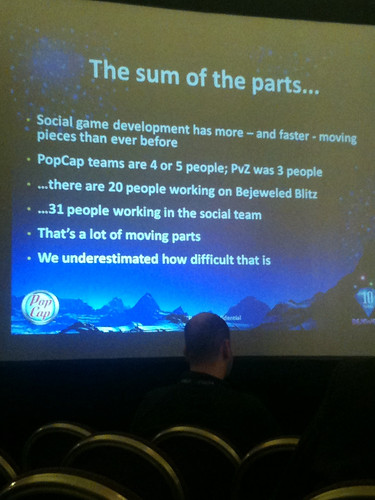
The focus of the talk though was around how PopCap are making the transition from Casual games to Social games. This quite often gets mixed up into the same thing. Dave explained how people played PopCap games in their droves but a complete standalone experience. Now with Bejeweled Blitz they have introduced social networking elements to allow people to share scores with friends. There are many aspects to this that ramp up the complexity of doing this. Having had games in flash on the browser, having iphone version etc they then have the complexity of trying to make the experiences and the relative scoring systems the same across all the platforms. Each platform may look very similar but in reality, as Dave said, PopCap spend more time than is natural working out how it feels when the gems fall.
Dave said that PopCap were not only putting social features into all their games, including cross platform interactions but they are also creating actual social games. This will be interesting to see how the transition happens in game design from a recognised franchise point of view.
Like Thomas before him Dave indicated the massive alteration that happens in the business when it goes to actual online, not just delivery online. They have had to go from teams of 3 or 4 people to teams of 30+ to deal with the constant iterations.
Adam Boyles – Beefy Media (Formely CapCom)
Round2 – Get ready for convergent gaming
The basic premise here was that convergent gaming, i.e. a game experience or brand that crosses platforms and ways of interacting with it has been talked about for a long time but might now be coming. This was much more than simply porting game x to platform y. It was about fundamentally different experiences suited to different ways people interact. He told a few war stories about the restrictions put on CapCom by both Sony and Microsoft as they were delivering some of the downloadable titles, and how when you have two competing giants you don’t have to take their word for it, but push them.
I found this all interesting as I tend to be getting data from one place and effecting change elsewhere even with the virtual worlds. Closed platforms development wise, or very expensive ones are of no interest to me, but being able to get data feeds from them very much is.
Adam also talked about the problems of just converting content, or of only doing half a job when doing an HD remix. The fans will tell you when you are not doing it right. Hence CapCom always gets the fans involved.
Nils-Holger Henning Bigpoint
How 100 users turned into 100 million – a browser game success story
Bigpoint has 130 million registered users. That is a lot. They come to play top quality web based games. Bigpoint are pushing the envelope of what that means with both Java and Unity and Flash. They deal in MMO massive scale. Nils-Holger indicated the shock and exponential shift in effort required in MMO’s. He also re iterated the 10% rule. Most of the 130 million will not be paying anything but 10% will start to. That is why free works. For some of their early games they still have massive longterm support from the users. People come for the game and stay for the community.
With respect to taking payment he also said something that makes a great deal of sense economically, but many may laugh.
If you set a subscription price for anything you have a massive impact on that 10% that will pay something. i.e. many will drop out. If you set the subs at $10 but they are prepared to spend $5 you are shooting yourself in the foot. He also alluded to the other end of the market though. (This is my favourite anecdote). There are some people with so much money that they would just not bother with $10 subscription. They would however pay $50,000 for a custom piece of armour in a game. This is about paying for kudos and quality. It is the couture end of the market. People who spend 10k on a dress will not shop at Primark. The product may look the same but its not. So, as he said, 2 people paying $50k each for one piece of custom content is worth a lot of $10 subscribers.
He went on to show Poisonville and then Battlestar Galactica online both extremely rich visuals and in browser. One Java one Unity3d.
Another interesting point was that Bigpoint are now targeting the US more. He admitted they had treated it in the same way the US tends to treat Europe. “send a junior to london and he can cover germany, france, spain, italy …). Its a much bigger market and deserves proper attention.
David Helgason, Unity Technologies
Gamification: How games are everywhere
David was not specifically talking about Unity3d, though of course it came up as a scene setting. It was interesting (as I tweeted) to see Mark Rein of Unreal sat in the front row as clearly Unity has a disruptive influence over the engine market. Unity3d I still find really interesting and exciting.
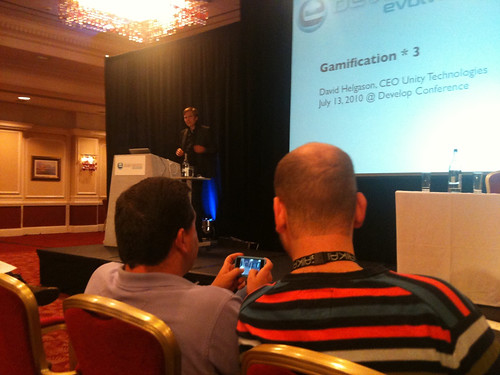
The core of David’s talk was that we are at such an interesting point in the use of games and of games technology. He cited Jesse Schell’s pitch on life achievements which is turning into as seminal a work as Chris Anderson’s Free or Malcom Gladwell’s tipping point.
David also said that there are so many programmers out there, many of them probably starting to develop in the first place because they really wanted to build games, but have ended up not doing that. (sounds familiar 🙂 )
He also said that we had an education systems that was creating technically literate students with a will to create.
The third element was that of content creation and the change in the web to allow and encourage that content
Finally The technology and community is in place to work and collaborate with anyone anywhere (as I say everywhere is local)
This creates a perfect storm (which was cheekily shown with a backdrop picture of the icelandic volcano that disrupted all our lives, David is originally from Iceland)
David’s pitch was quite handy when explaining to people in the evening when asked “so what do you do then” the whole metaverse evangelist thing and the education in virtual worlds and business use of game tech ended up with people saying “oh so ramification then”. So thankyou David 🙂
A cracking day and looking forward to day 2
Heading for Brighton Develop
Tomorrow sees the start of 3 days in Brighton at the Develop conference. As I have mentioned before it is unusual to be going to a conference and not actually presenting. Though in part that is because Develop has grown up form a pure games development background and with things like Evolve as a track is starting to head towards what I do.

It feels like it will be an exciting one again this year as last year was great.
The past year I have met some of my game design heroes in various capacities and with an increasing crossover into the game environments, and the massive impact of things such as Kinect and Nintendo 3DS on the horizon we may be at an important crossover.
I will also be sharing the launch of the British Computer Society Animation and Games Development industry group which launches this month. This is very exciting as again it starts to show the crossover and connections. After all this is all tech, it needs more tech skills than ever, but blends with other creative endeavours.
If you are interested please contact me or want to discuss this group and maybe present or help in the future once we get going.
It will also be an outing for my new feeding edge tshirt so look out for me if you are there and say hi.
Gadgets and innovation, value in joking around
Back in the 80’s many of us pre teens got into metal detecting, it along with skateboards, CB radio and arcade video games were all gadget powered exciting and interesting ways to explore the world. The home computer revolution was in on that wave too.
The metal detecting was an interesting form of gambling or hi-tech fishing. Hours of fruitless wandering, but with a gadget held in hand to sweep the ground. Wearing headphones and listening to static and analogue electronic beeps. We mixed and matched between attempts to treasure hunt (responsibly in fields with permission) and sweeping the beach for left coins. It often led to looking at old maps and trying to figure out where to go.
We were working with commercially available technology, but it was really just adapted from the way metal detecting had always been done. That was of course a military application. The purpose of the metal detector disc on the end of a long handle allowing the user to sweep the ground in front of them was clearly to protect the user from the metal they are looking for, namely mines.
I was reminded of the metal detecting craze and the 80’s kit we used by reading this months Stuff magazine ( it and T3 being a great repository of gadget goodness) with the mention of these treasure seeker sandals.

It turns out these have been around for a little while (a year of so). Basically you wear the meta detector. Now there may be some usability issues here, but as most social metal detecting does not need to protect you from the thing you are searching for it makes sense to do something like this. It challenges the “this is the way we have always done it”.
Even before these became a product though the idea was muted on the patent busting Half Bakery where people share a half baked idea just to get discussion going. I say patent busting as if you are about to try and write up a patent and something has already been published that is close to that idea in the public domain then you have to work a bit harder to describe why its not this piece of prior art.
It has always seemed important to me to explore those things that seem funny or ludicrous initially, as at those extremes, far from the way we currently to things there is always some middle ground to break.
Using the things we already have and combining them opens up interesting opportunities. So its worth just joking about something, standing back from it and having a non serious discussion. It’s not frivolous, its essential to pushing things forward.
If stuck for inspiration just a random click through Half Bakery might get you going too.

